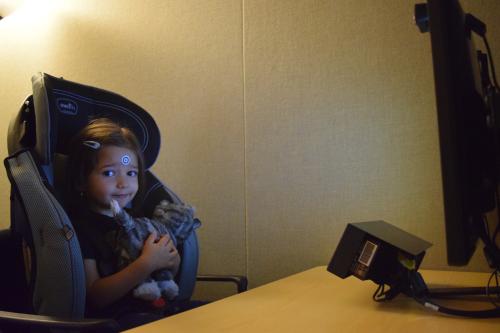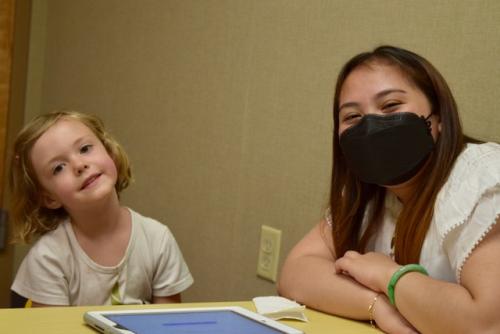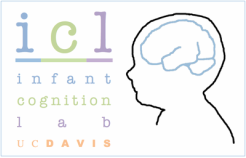
What is this study about?
In this study we will learn how children come to understand objects and spatial relations. We do this by testing many aspects of children’s development. We will measure children’s developing motor skills and language abilities. We will also observe children as they do puzzles, play with blocks, and other toys. Finally, we will test children’s ability to recognize objects seen from different viewpoints, as well as other aspects of how they see visual patterns. By understanding how these skills develop and interact together from infancy to the preschool years we can better understand the early development of spatial abilities, which are important for math and science learning.
Why are we doing this research?
The ability to perceive and manipulate objects in different viewpoints involves many mental processes. Not only does it require your visual system while you look at the object, but it also involves thinking about how you’re going to manipulate the object, and motor (body movement) abilities to physically manipulate the object. We are interested in studying the interaction of these systems, because we don’t fully know how they work together. More so, we are interested in identifying what experiences and mechanisms shape the development of these abilities. We are testing kids between one- and four-years-old over the course of 6 months, to assess the development and interaction of these abilities.
We are interested in studying how these systems develop because some research suggests that these early abilities may be related to children’s later developing math abilities and other skills related to Science, Technology, Engineering, and Mathematics (STEM) fields [1, 2]. Because spatial and object concept abilities develop in infancy, we can understand more about these later developing abilities by studying the trajectory of how these skills develop together.
What kinds of tasks are involved in this study?
Children will come first into the lab when they are between the ages of 1.5 and 3.5 years old, then again 6 months later. At each visit, children first complete two eye tracking tasks. These tasks are simple and straightforward; they require that children look at a computer screen as pictures, cartoon images, and colored shapes appear.

Then, children play with various toys and puzzles. We also play some games to assess children’s fine motor development; these games involve drawing and picking up objects. Children 2 years and older also complete a few tasks on a tablet, similar to matching and other games your child may have played before. Finally, children 3 years and older will complete a vocabulary assessment on an iPad which involves pointing to named pictures. Parents will be asked to complete a series of questionnaires that provide us with general information about your family and household, as well as questionnaires about child’s previous experiences playing with toys, and, for children younger than 3, a questionnaire about the words your child knows and says.

FAQ’s:
How long is the study?
Each visit is scheduled to last approximately two hours. If your child participates, we will schedule two visits, 6 months apart. The first visit will be when children are between the ages of 18 and 42 months, and the second visit will be 6 months later. So, the youngest children who participate will have their first visit at 18 months, will have their second visit at 24 months (2 years), and the oldest children whose first visit is at 42 months will have their second visit at 48 months (4 years). We will contact you prior to scheduling each visit to find a time that works best for you. If you are interested in signing up to participate, please visit our study pages website.
Do I get my child’s results?
We don’t store any identifying information with your child’s data; this means we can’t link our results to your child and tell you anything specific about your child’s abilities. Our study will tell us about the development of children in general, and not about differences between different children. Once we will publish our findings about how children between 1- and 4-years-old develop in these areas, we will update our publications page with the results. We will also keep this website up-to-date with any findings we may present at conferences.
Do we offer any compensation?
At the end of each visit, we will give your child a book and we will give you a $50 target gift card. Your child will receive a total of 2 books and you will receive $100 in Target gift cards after you and your child complete both visits.
Where are we located?
Although we’re part of UC Davis, we’re located off-campus (about 2 miles east of campus). We’re just north of I-80 off of 2nd street, between Mace Blvd and Pole Line Rd. Parking is free.
Are your procedures safe?
Yes! Most of the tasks that your child will do are like the games and puzzles children play with every day. In fact, many of the toys we use are commercially available. We don’t use any invasive procedures. For some of our tasks, we will use a special camera and an infrared light source to measure where your child is looking at the screen; the infrared light we use is common in our everyday lives. It is no different than the type of light children are exposed to from the sun or and other sources. For kids 2 years and older, they will play a game on a tablet and/or iPad. During these games, your child will have the chance to earn some stamps.
Can we bring other children to the study with us?
Yes, we will have a research assistant stay and play with your other children in a separate room during the study.
How do I participate?
Please check out our study pages website for more information about eligibility requirements, and to sign up to participate in this study. You can also contact us to find out more information about the study.
This study is being conducted in collaboration with Lisa Oakes at UC Davis, Marianella Casasola at Cornell University, and Vanessa LoBue at Rutgers University. Together, these three sites will work on collecting and analyzing data for this study, to gain a better understanding of the development of mental rotation from infancy to the preschool years.
References
- Mix, K. S., Levine, S. C., Cheng, Y.-L., Young, C., Hambrick, D. Z., Ping, R., & Konstantopoulos, S. (2016). Separate but correlated: The latent structure of space and mathematics across development. Journal of Experimental Psychology: General, 145, 1206–1227. doi:10.1037/xge0000182
- Wai, J., Lubinski, D., & Benbow, C. P. (2009). Spatial Ability for STEM Domains: Aligning Over 50 Years of Cumulative Psychological Knowledge Solidifies Its Importance. Journal of Educational Psychology, 101, 817–835. doi:10.1037/a0016127
